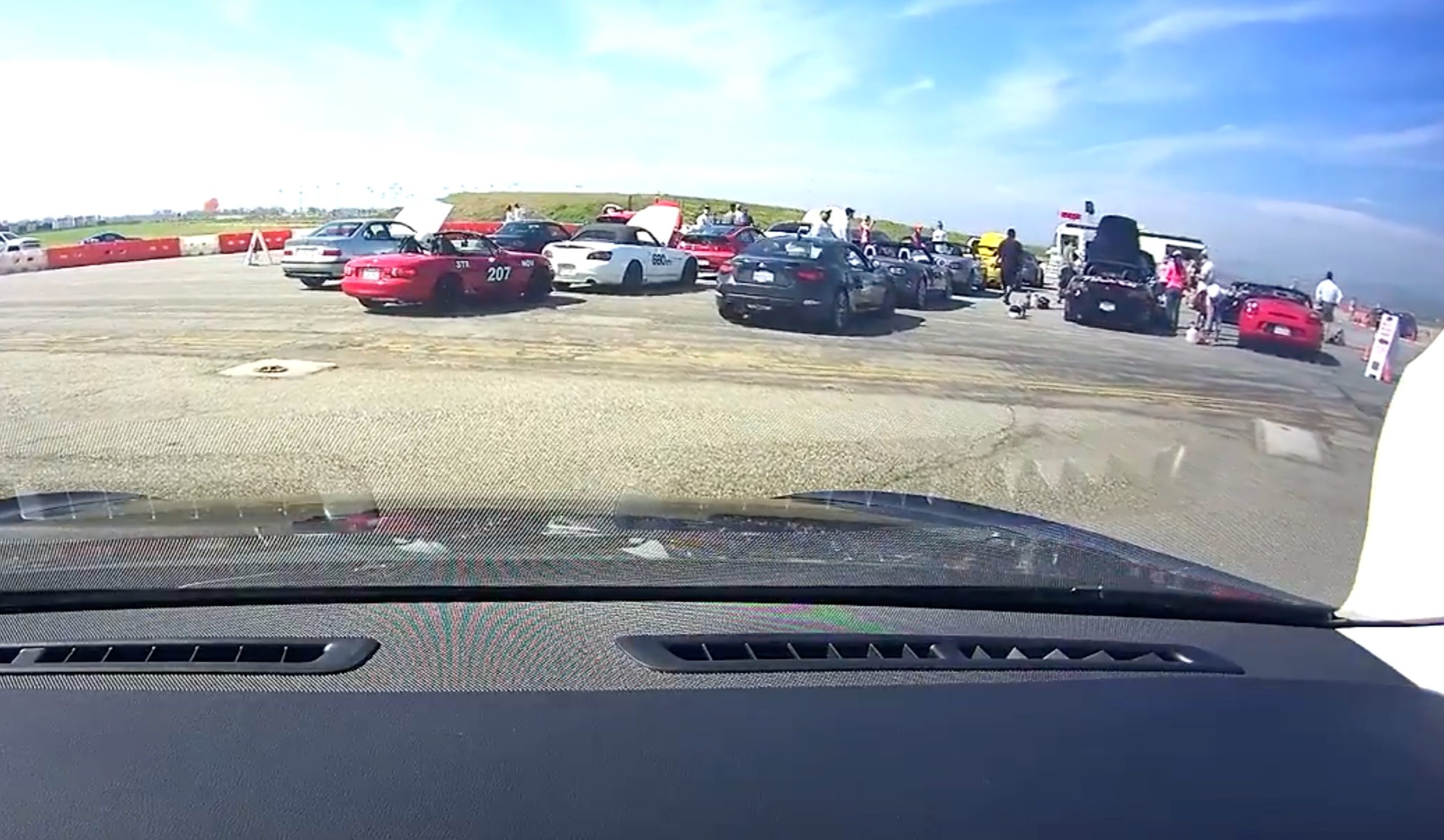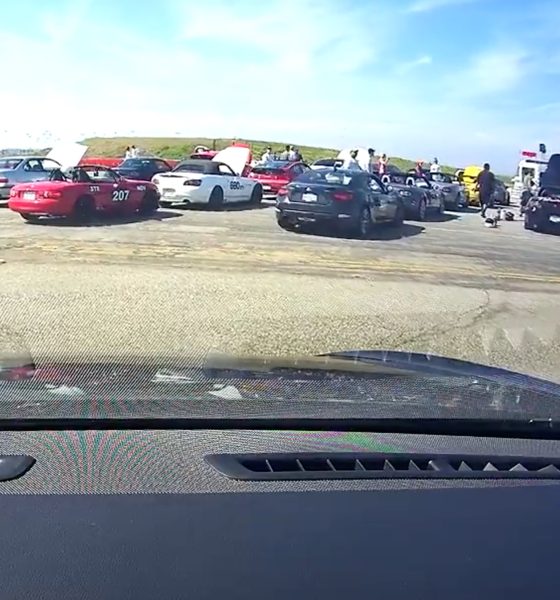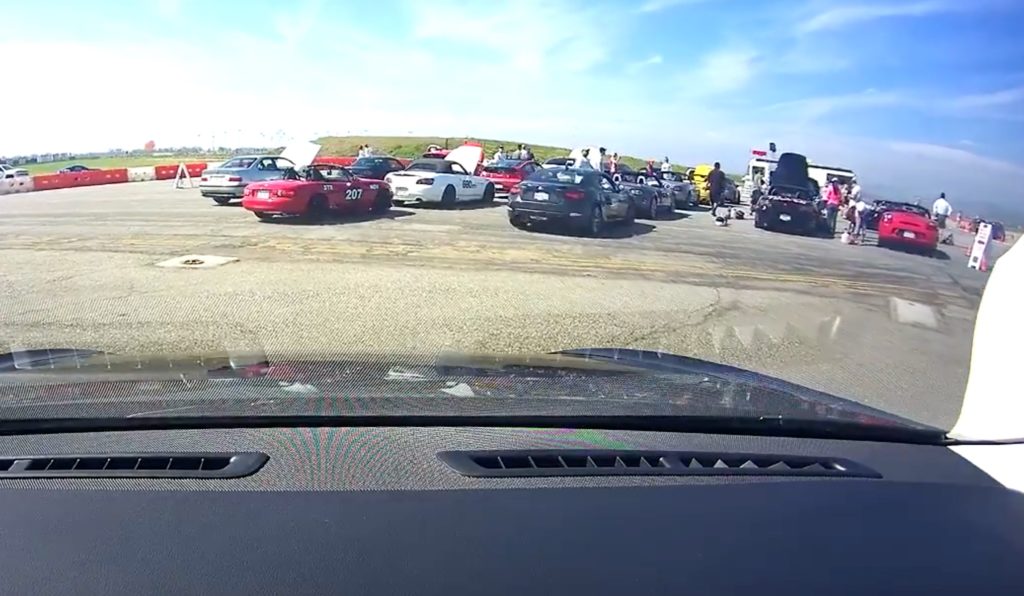

Lifestyle
Watch this Tesla Model S conquer Autocross [Video]
The following post was originally published on EVANNEX
Grant M. is like a superhero with a secret identity – during the week, he works as a lawyer, but on the weekends, he takes his Tesla S60 to the autocross track to do battle with the forces of fossil fuel.
Autocross, also called solo or (in Canada) autoslalom, is a timed competition in which drivers navigate a course that includes straightaways, curves and slaloms. It’s less about fast acceleration and high speed than about handling and precision driving. The autocross community is egalitarian – any kind of car can compete, and drivers of all skill levels are welcome. Courses are usually temporary, set up with cones on a speedway parking lot or a disused airstrip – this prevents experienced drivers from gaining an advantage, as the course may be different every time.
According to the Sports Car Club of America, most autocross courses are designed so that the cars won’t exceed normal highway speeds – around 55-60 mph. However, “that doesn’t mean they are slow. Well-designed courses will feel plenty fast as you attempt to maintain that speed through a series of elements. Imagine slaloming every barrel in a 55-mph construction zone, and you will start to get the idea.” As the New Brunswick Sporting Car Club puts it, “While AutoSlalom events typically involve lower speeds than other motorsports, the number of driver inputs per second is comparable to Formula One.”
Driving an electric vehicle (EV) on the autocross track is very different from driving a gas-burner. The EV’s instant acceleration gives it an advantage coming out of corners onto a straightaway. However there’s also a drawback: EVs, especially the Tesla Model S, weigh a lot more than their gas-powered counterparts. “Trying to take a corner fast and hard with a car that weighs 4,500 to 5,000 pounds” isn’t easy, Grant told us. “I’m probably 1,000 to 1,500 pounds heavier than every other car in my class.”
Regenerative braking presents another challenge. “It’s like engine braking, as if you were downshifting. You have to take that into account too – it can slow you down pretty far on a really sharp corner, and sometimes that can lead to the back end of the car sweeping out, just because while you’re braking and taking a turn, you lose contact with the tires.”
In a sense, an EV has the opposite attributes of a gas car: it’s slower in the tight turns, but faster on the straight sections. Grant’s competitors know they have to watch out for the Tesla on the straightaways. “I can’t take the corners as fast as everybody else, but when I see a straightaway, with my instant torque and acceleration I can make up some time.”
The Model S is not an ideal autocross car, so Grant doesn’t expect to win a first-place finish any time soon, but his times are improving, and he often earns a respectable place in the top 3 to 5. “It’s very hard to beat cars that are made by the manufacturers to actually go on tracks.” The BMW M3 seems to be the number-one competitor. “They’re very fast and much smaller.”
Grant competes at SCCA events in Southern California in the F Street class, in which cars must be totally stock – the only modification allowed is the tires, so some drivers opt to use “stickier” models. He’s the only Tesla driver on the Southern Cal autocross scene (and apparently the only EV driver, though he has seen a couple of Volts at events), so he and his car get a lot of attention.
Although he’s the only electric driver among a field of car guys and motorheads, Grant says he has encountered no chauvinism or hostility – on the contrary, most of the other drivers find his Tesla Model S very interesting, and are excited about the technology (he does hear some jokes about his vehicle’s silence). This being Southern California, some of the other drivers own Teslas themselves, although they prefer to bring their M3s or Corvettes to the autocross track.
In fact, Grant has become something of a Tesla ambassador to the autocross community – all the car guys have heard about the P100D and its 2.2-second 0-60 time, but he has educated many of them about nifty features such as Autopilot. Everybody wants to take the Model S for a spin, and we all know how that often ends up – it’s possible that Grant has inspired a car guy or two to buy a Tesla of their own.
And why shouldn’t you follow his example? Autocross events are held in all 50 states, and beginning racers are welcome. If you’ve ever wondered how your Model S might perform on a track, an autocross event could be a good place to find out. You’ll have fun, improve your driving skills, and help to spread the word about driving electric.

Lifestyle
Tesla Model S Plaid battles China’s 1500 hp monster Nurburgring monster, with surprising results
There is just something about Tesla’s tuning and refinement that makes raw specs seem not as game-changing.

The Tesla Model S Plaid has been around for some time. Today, it is no longer the world’s quickest four-door electric sedan, nor is it the most powerful. As per a recent video from motoring YouTube channel Carwow, however, it seems like the Model S Plaid is still more than a match for some of its newer and more powerful rivals.
The monster from China
The Xiaomi SU7 Ultra is nothing short of a monster. Just like the Model S Plaid, it features three motors. It also has 1,548 hp and 1,770 Nm of torque. It’s All Wheel Drive and weighs a hefty 2,360 kg. The vehicle, which costs just about the equivalent of £55,000, has been recorded setting an insane 7:04.957 at the Nurburgring, surpassing the previous record held by the Porsche Taycan Turbo GT.
For all intents and purposes, the Model S Plaid looked outgunned in Carwow’s test. The Model S Plaid is no slouch with its three motors that produce 1,020 hp and 1,420 Nm of torque. It’s also a bit lighter at 2,190 kg despite its larger size. However, as the Carwow host pointed out, the Model S Plaid holds a 7:25.231 record in the Nurburgring. Compared to the Xiaomi SU7 Ultra’s record, the Model S Plaid’s lap time is notably slower.
Real-world tests
As could be seen in Carwow’s drag races, however, Tesla’s tech wizardry with the Model S Plaid is still hard to beat. The two vehicles competed in nine races, and the older Model S Plaid actually beat its newer, more powerful counterpart from China several times. At one point in the race, the Xiaomi SU7 Ultra hit its power limit due to its battery’s temperature, but the Model S Plaid was still going strong.
The Model S Plaid was first teased five years ago, in September 2020 during Tesla’s Battery Day. Since then, cars like the Lucid Air Sapphire and the Xiaomi SU7 Ultra have been released, surpassing its specs. But just like the Model Y ended up being the better all-rounder compared to the BYD Sealion 7 and the MG IM6, there is just something about Tesla’s tuning and refinement that makes raw specs seem not as game-changing.
Check out Carwow’s Model S Plaid vs Xiaomi SU7 drag race video below.
Lifestyle
500-mile test proves why Tesla Model Y still humiliates rivals in Europe
On paper, the BYD Sealion 7 and MG IM6 promised standout capabilities against the Model Y.

BYD is seeing a lot of momentum in Europe, so much so that mainstream media has taken every opportunity to argue that the Chinese automaker has beaten Tesla in the region. But while BYD sales this year in Europe are rising and Tesla’s registrations remain challenged, the raw capabilities of vehicles like the Model Y are difficult to deny.
This was highlighted in a 500-mile challenge by What Car? magazine, which showed that the new Tesla Model Y is more efficient, cheaper to run, and more reliable than rivals like the BYD Sealion 7, and even the nearly 400 KW-charging MG IM6.
Range and charging promises
On paper, the BYD Sealion 7 and MG IM6 promised standout capabilities against the Model Y. The Sealion 7 had more estimated range and the IM6 promised significantly faster charging. When faced with real-world conditions, however, it was still the Model Y that proved superior.
During the 500-mile test, the BYD nearly failed to reach a charging stop, arriving with less range than its display projected, as noted in a CarUp report. MG fared better, but its charging speeds never reached its promised nearly-400 kW charging speed. Tesla’s Model Y, by comparison, managed energy calculations precisely and arrived at each stop without issue.
Tesla leads in areas that matter
Charging times from 25% to 80% showed that the MG was the fastest at 17 minutes, while Tesla and BYD were close at 28 and 29 minutes, respectively. Overall efficiency and cost told a different story, however. The Model Y consumed 19.4 kWh per 100 km, compared to 22.2 for MG and 23.9 for BYD. Over the full trip, Tesla’s charging costs totaled just £82 thanks to its supercharger network, far below BYD’s £130 and MG’s £119.
What Car? Magazine’s testers concluded that despite BYD’s rapid sales growth and the MG IM6’s seriously impressive charging speeds, Tesla remains the more compelling real-world choice. The Model Y just offers stability, efficiency, and a proven charging infrastructure through its Supercharging network. And as per the magazine’s hosts, the Model Y is even the cheapest car to own among the three that were tested.
Watch What Car? Magazine’s 500-mile test in the video below.
Lifestyle
Tesla Cybertruck slapped with world’s least intimidating ticket, and it’s pure cringe
One cannot help but cringe and feel second-hand embarrassment at the idea of a person just driving around with a stack of these babies.

A Cybertruck parked at Stanford Shopping Center in California was recently hit with what might be the most try-hard piece of paper ever slipped under a wiper blade: a “fake citation” accusing the driver of supporting a “fascist car.”
The note, shared on X by Tesla staff program manager Ryan Torres, quickly made the rounds on X, where it quickly gained attention as an example of how not to protest.
The world’s least intimidating ticket
According to the citation, the supposed “violation” was “driving a fascist car.” The remedial action? Take the bus, call an Uber, or ride a bike. The note also dubbed Elon Musk a “chainsaw-wielding Nazi billionaire.” Now, protests against Tesla and Elon Musk have become commonplace this year, but one cannot help but cringe and feel second-hand embarrassment at the idea of a person just driving around with a stack of fake anti-Tesla/Musk citations.
Torres pointed out the irony himself in his post on X. Tesla currently employs over 140,000 Americans, and SpaceX has put the U.S. firmly back at the top of space technology. As Torres put it, maybe the person behind the world’s least intimidating ticket should “read a book on innovation before vandalizing” other people’s property.
Peak performative clownery
Not to mention that the fake ticket’s logic collapses under its own weight. EVs like the Cybertruck are literally designed to reduce emissions, not “destroy the economy.” If anything, Tesla has bolstered the United States’ economy by fueling jobs in engineering, manufacturing, and clean energy. It’s not the first time a Tesla has been the target of vandalism or politically charged notes, but this one stands out for sheer cringe value.
Torres summed it up neatly: “Peak clownery.” On that point, at least, the citation earns full marks. In a way, though, perhaps cringe fake tickets are not as bad as the literal firebombs that were being thrown at Tesla stores and cars earlier this year because some critics were gleefully misinformed about Elon Musk.









